Application of Parallel Factor Analysis (PARAFAC) to the Regional Characterisation of Vineyard Blocks Using Remote Sensing Time Series
Abstract
1. Introduction
- to propose a multi-way approach aiming to identify spectro-temporal profiles from a time series of images, to assess the value of the approach for its potential to generate knowledge in a viticulture case study, and to determine whether the spatial patterns highlighted can be considered relevant with regard to the experts’ observations, and;
- to address the possible limitations of the approach when dealing with large-scale time series of multispectral images without ground truth data.
2. Materials and Methods
2.1. Notations
2.2. PARAFAC Method
2.3. Case Study
2.3.1. Study Area
2.3.2. Remote Sensing Data
2.4. Modelling
2.4.1. Data Array Construction
2.4.2. PARAFAC Model
2.4.3. Component Selection
2.5. Validation of the Model
- A geostatistical analysis (see next section) to test whether the score values were spatially autocorrelated. The underlying hypothesis is that the environmental variables (soil, climate, and associated training practices, etc.) that are likely to explain the differences between blocks at the regional scale are spatially organised (not random). Consequently, if score values resulting from the PARAFAC models are not randomly distributed at the regional level, they are assumed to be related to environmental variables.
- An assessment of the coherence of the spatial distribution of the score values against expert knowledge of the diversity and spatial distribution of soil, climate, and vineyard cultural practices in the region. The objective of this second step was to identify the relevance of the relationship between the scores and agri-environmental information. In order to do so, an original approach based on placing the human, i.e., local viticultural experts, at the centre of the study was conducted. Following the methodological framework of Pichon et al. (2019) [12], a global approach, a so-called ‘scenario simulation’ [25], was used. In this method, external reliability can be considered valid if the conclusions reached by different experts (at least two experts) coincide [26,27]. In order to facilitate the expert’s interpretation, maps of score values were produced at the regional level. These maps were created by interpolating (see next section) the scores observed on the 4978 vineyard blocks for each year (2019 and 2020) and for each component (F) when spatial autocorrelation was observed.
2.6. Spatial Analysis and Mapping
- if Ic is less than or equal to 25%, the distribution is considered strongly spatially organised (high auto correlation);
- if Ic is between 25 and 75%, the distribution is considered moderately spatially organised; and,
- if Ic is higher than 75%, the distribution is considered weakly spatially organised.
2.7. Experts Evaluation
3. Results
3.1. Component Selection
3.2. Data Signal Decomposition
3.3. Spatial Analysis and Characterisation
3.4. Comparaison of Cross-Observation by Experts
4. Discussion
5. Conclusions
Supplementary Materials
Author Contributions
Funding
Institutional Review Board Statement
Informed Consent Statement
Data Availability Statement
Acknowledgments
Conflicts of Interest
References
- Griffiths, G.H.; Lee, J. Landscape Pattern and Species Richness; Regional Scale Analysis from Remote Sensing. Int. J. Remote Sens. 2000, 21, 2685–2704. [Google Scholar] [CrossRef]
- Gilbertson, J.K.; van Niekerk, A. Value of Dimensionality Reduction for Crop Differentiation with Multi-Temporal Imagery and Machine Learning. Comput. Electron. Agric. 2017, 142, 50–58. [Google Scholar] [CrossRef]
- Weiss, M.; Jacob, F.; Duveiller, G. Remote Sensing for Agricultural Applications: A Meta-Review. Remote Sens. Environ. 2020, 236, 111402. [Google Scholar] [CrossRef]
- Huang, Y.; Chen, Z.; Yu, T.; Huang, X.; Gu, X. Agricultural Remote Sensing Big Data: Management and Applications. J. Integr. Agric. 2018, 17, 1915–1931. [Google Scholar] [CrossRef]
- Kroonenberg, P.M.; Harshman, R.A.; Murakami, T. Analysing Three-Way Profile Data Using the Parafac and Tucker3 Models Illustrated with Views on Parenting. Appl. Multivar. Res. 2009, 13, 5. [Google Scholar] [CrossRef][Green Version]
- Kiers, H.; Mechelen, I. Three-Way Component Analysis: Principles and Illustrative Application. Psychol. Methods 2001, 6, 84–110. [Google Scholar] [CrossRef]
- Khanal, S.; Kc, K.; Fulton, J.P.; Shearer, S.; Ozkan, E. Remote Sensing in Agriculture—Accomplishments, Limitations, and Opportunities. Remote Sens. 2020, 12, 3783. [Google Scholar] [CrossRef]
- Esbensen, K.; Geladi, P. Strategy of Multivariate Image Analysis (MIA). Chemom. Intell. Lab. Syst. 1989, 7, 67–86. [Google Scholar] [CrossRef]
- Verbeeck, N.; Caprioli, R.M.; Van de Plas, R. Unsupervised Machine Learning for Exploratory Data Analysis in Imaging Mass Spectrometry. Mass Spectrom. Rev. 2020, 39, 245–291. [Google Scholar] [CrossRef]
- Harshman, R. Foundations of the PARAFAC Procedure: Models and Conditions for an Explanatory Multi-modal Factor Analysis. UCLA Work. Pap. Phon. 1970, 16, 1–84. [Google Scholar]
- Bro, R. PARAFAC. Tutorial and Applications. Chemom. Intell. Lab. Syst. 1997, 38, 149–171. [Google Scholar] [CrossRef]
- Pichon, L.; Leroux, C.; Macombe, C.; Taylor, J.; Tisseyre, B. What Relevant Information Can Be Identified by Experts on Un-manned Aerial Vehicles’ Visible Images for Precision Viticulture? Precis. Agric. 2019, 20, 278–294. [Google Scholar] [CrossRef]
- Yang, X.; Yu, X.; Cheng, J.; Zheng, R.; Wang, K.; Dai, Y.; Tong, N.; Chow, A. Impacts of Land-Use on Surface Waters at the Watershed Scale in Southeastern China: Insight from Fluorescence Excitation-Emission Matrix and PARAFAC. Sci. Total Environ. 2018, 627, 647–657. [Google Scholar] [CrossRef] [PubMed]
- Ouertani, S.S. Nway Partial Least Squares: Nouvelles Propriétés et Apports à la Discrimination des Données Métabolomiques. Ph.D. Thesis, University of Geneva, Geneva, Switzerland, 2014. [Google Scholar]
- Xu, X.; Kang, J.; Shen, J.; Zhao, S.; Wang, B.; Zhang, X.; Chen, Z. EEM–PARAFAC Characterization of Dissolved Organic Matter and Its Relationship with Disinfection by-Products Formation Potential in Drinking Water Sources of Northeastern China. Sci. Total Environ. 2021, 774, 145297. [Google Scholar] [CrossRef]
- Andersson, C.; Bro, R. The N-Way Toolbox for Matlab. Chemom. Intell. Lab. Syst. 2000, 52, 1–4. [Google Scholar] [CrossRef]
- Giovos, R.; Tassopoulos, D.; Kalivas, D.; Lougkos, N.; Priovolou, A. Remote Sensing Vegetation Indices in Viticulture: A Critical Review. Agriculture 2021, 11, 457. [Google Scholar] [CrossRef]
- Zhou, Y.; Pei, F.; Xia, Y.; Wu, C.; Zhong, R.; Wang, K.; Wang, H.; Cao, Y. Assessing the Impacts of Extreme Climate Events on Vegetation Activity in the North South Transect of Eastern China (NSTEC). Water 2019, 11, 2291. [Google Scholar] [CrossRef]
- Sozzi, M.; Kayad, A.; Marinello, F.; Taylor, J.; Tisseyre, B. Comparing Vineyard Imagery Acquired from Sentinel-2 and Un-manned Aerial Vehicle (UAV) Platform. Oeno One 2020, 54, 189–197. [Google Scholar] [CrossRef]
- Fernández-Mena, H.; Frey, H.; Celette, F.; Garcia, L.; Barkaoui, K.; Hossard, L.; Naulleau, A.; Métral, R.; Gary, C.; Metay, A. Spatial and Temporal Diversity of Service Plant Management Strategies across Vineyards in the South of France. Analysis through the Coverage Index. Eur. J. Agron. 2021, 123, 126191. [Google Scholar] [CrossRef]
- Devaux, N.; Crestey, T.; Leroux, C.; Tisseyre, B. Potential of Sentinel-2 Satellite Images to Monitor Vine Fields Grown at a Territorial Scale. Oeno One 2019, 53, 52–59. [Google Scholar] [CrossRef]
- Lopez-Fornieles, E.; Brunel, G.; Rancon, F.; Gaci, B.; Metz, M.; Devaux, N.; Taylor, J.; Tisseyre, B.; Roger, J.-M. Potential of Multiway PLS (N-PLS) Regression Method to Analyse Time-Series of Multispectral Images: A Case Study in Agriculture. Remote Sens. 2022, 14, 216. [Google Scholar] [CrossRef]
- Hollstein, A.; Segl, K.; Guanter, L.; Brell, M.; Enesco, M. Ready-to-Use Methods for the Detection of Clouds, Cirrus, Snow, Shadow, Water and Clear Sky Pixels in Sentinel-2 MSI Images. Remote Sens. 2016, 8, 666. [Google Scholar] [CrossRef]
- Alam, M.S.; Islam, M.N.; Bal, A.; Karim, M.A. Hyperspectral Target Detection Using Gaussian Filter and Post-Processing. Opt. Lasers Eng. 2008, 46, 817–822. [Google Scholar] [CrossRef]
- Wacheux, F. Méthodes Qualitatives de Recherches En Gestion; Economica: Paris, France, 1996; p. 290. [Google Scholar]
- Shadish, W.R.; Cook, T.D.; Campbell, D.T. Experimental and Quasi-Experimental Designs for Generalized Causal Inference; Houghton Mifflin Company: Boston, MA, USA, 2002. [Google Scholar]
- Drost, E. Validity and Reliability in Social Science Research. Educ. Res. Perspect. 2011, 38, 105–124. [Google Scholar]
- Cambardella, C.A.; Moorman, T.B.; Novak, J.M.; Parkin, T.B.; Karlen, D.L.; Turco, R.F.; Konopka, A.E. Field-Scale Variability of Soil Properties in Central Iowa Soils. Soil Sci. Soc. Am. J. 1994, 58, 1501–1511. [Google Scholar] [CrossRef]
- Leroux, C.; Jones, H.; Pichon, L.; Guillaume, S.; Lamour, J.; Taylor, J.; Naud, O.; Crestey, T.; Lablee, J.-L.; Tisseyre, B. GeoFIS: An Open Source, Decision-Support Tool for Precision Agriculture Data. Agriculture 2018, 8, 73. [Google Scholar] [CrossRef]
- Oliver, M.A.; Webster, R. A Tutorial Guide to Geostatistics: Computing and Modelling Variograms and Kriging. Catena 2014, 113, 56–69. [Google Scholar] [CrossRef]
- Lopez-Fornieles, E.; Brunel, G.; Devaux, N.; Roger, J.-M.; Tisseyre, B. Is It Possible to Assess Heatwave Impact on Grapevines at the Regional Level with Time Series of Satellite Images? Agronomy 2022, 12, 563. [Google Scholar] [CrossRef]
- Khadse, G.K. Spectral Reflectance Characteristics of the Soils on Basaltic Terrain of Central Indian Plateau. J. Indian Soc. Remote Sens. 2012, 40, 717–724. [Google Scholar] [CrossRef]
- Roman, A.; Ursu, T. Multispectral Satellite Imagery and Airborne Laser Scanning Techniques for the Detection of Archaeo-logical Vegetation Marks. In Landscape Archaeology on the Northern Frontier of the Roman Empire at Porolissum: An Interdisciplinary Research Project; Coriolan, H.O., Vlad-Andrei, L., Eds.; Mega Publishing House: Cluj-Napoca, Romania, 2016; pp. 141–152. [Google Scholar]
- de Juan, A.; Tauler, R. Comparison of Three-Way Resolution Methods for Non-Trilinear Chemical Data Sets. J. Chemom. 2001, 15, 749–771. [Google Scholar] [CrossRef]
- Tucker, L.R. Some mathematical notes on three-mode factor analysis. Psychometrika 1966, 31, 279–311. [Google Scholar] [CrossRef] [PubMed]
- Tauler, R.; Smilde, A.; Kowalski, B. Selectivity, local rank, three-way data analysis and ambiguity in multivariate curve resolution. J. Chemom. 1995, 9, 31–58. [Google Scholar] [CrossRef]
- Pomareda, V.; Guamán, A.V.; Mohammadnejad, M.; Calvo, D.; Pardo, A.; Marco, S. Multivariate curve resolution of nonlinear ion mobility spectra followed by multivariate nonlinear calibration for quantitative prediction. Chemom. Intell. Lab. Syst. 2012, 118, 219–229. [Google Scholar] [CrossRef]
- Gómez-Sánchez, A.; Marro, M.; Marsal, M.; Zacchetti, S.; Rocha de Oliveira, R.; Loza-Alvarez, P.; de Juan, A. Linear un-mixing protocol for hyperspectral image fusion analysis applied to a case study of vegetal tissues. Sci. Rep. 2021, 11, 18665. [Google Scholar] [CrossRef] [PubMed]
- Pearson, K. On Lines and Planes of Closest Fit to Systems of Points in Space (PDF). Lond. Edinb. Dublin Philos. Mag. J. Sci. 1901, 2, 559–572. [Google Scholar] [CrossRef]
- Wold, S.; Martens, H.; Wold, H. The multivariate calibration problem in chemistry solved by the PLS method. In Matrix Pencils; Ruhe, A., Kågstrøm, B., Eds.; Springer: Berlin/Heidelberg, Germany, 1982; pp. 286–293. [Google Scholar]

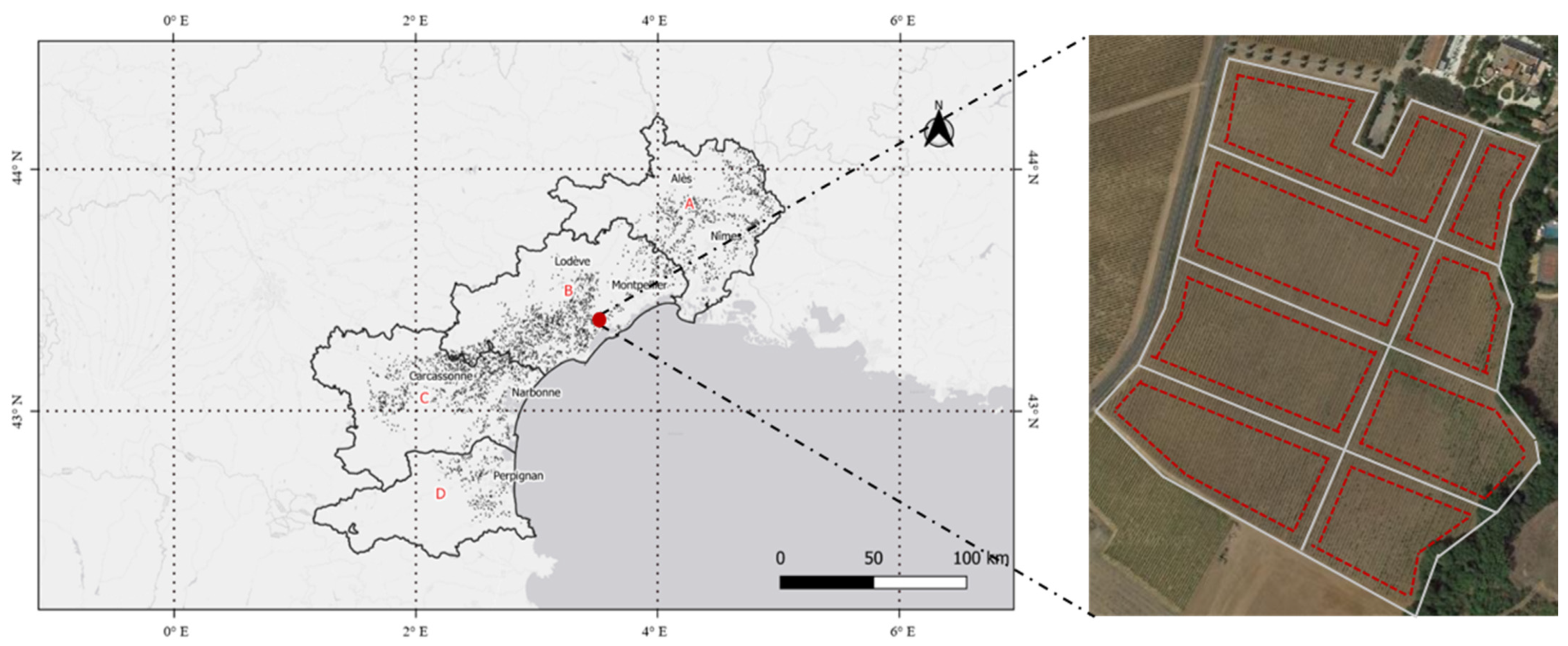


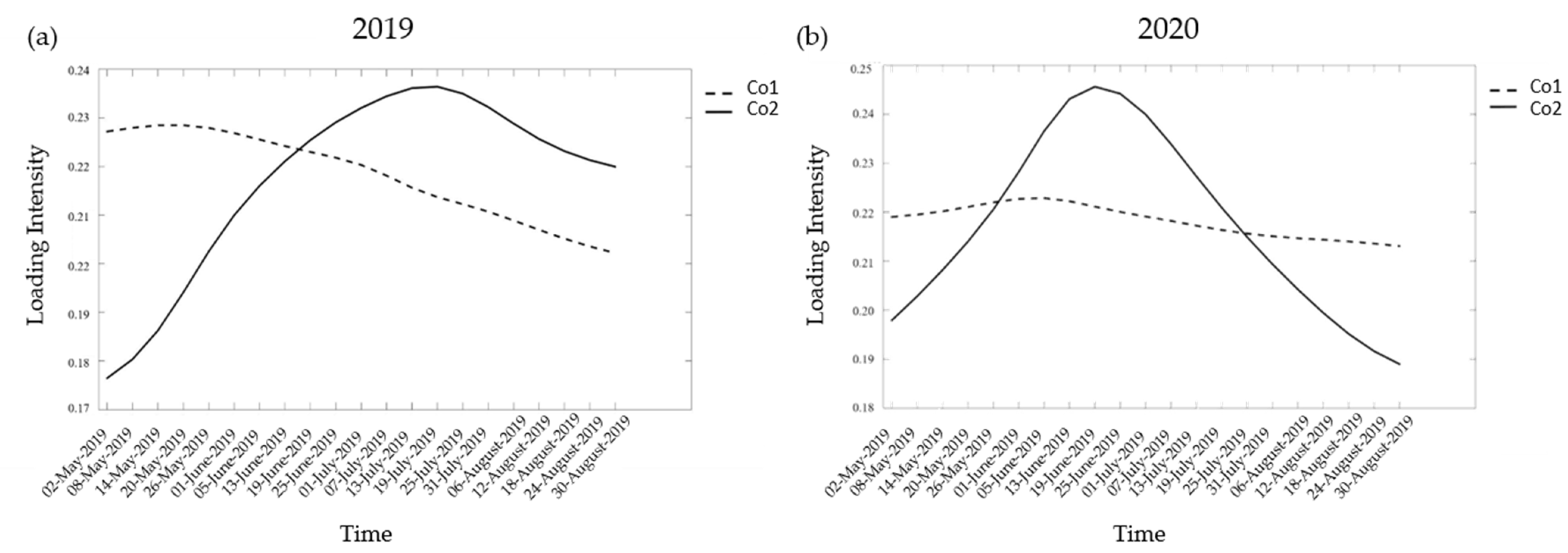
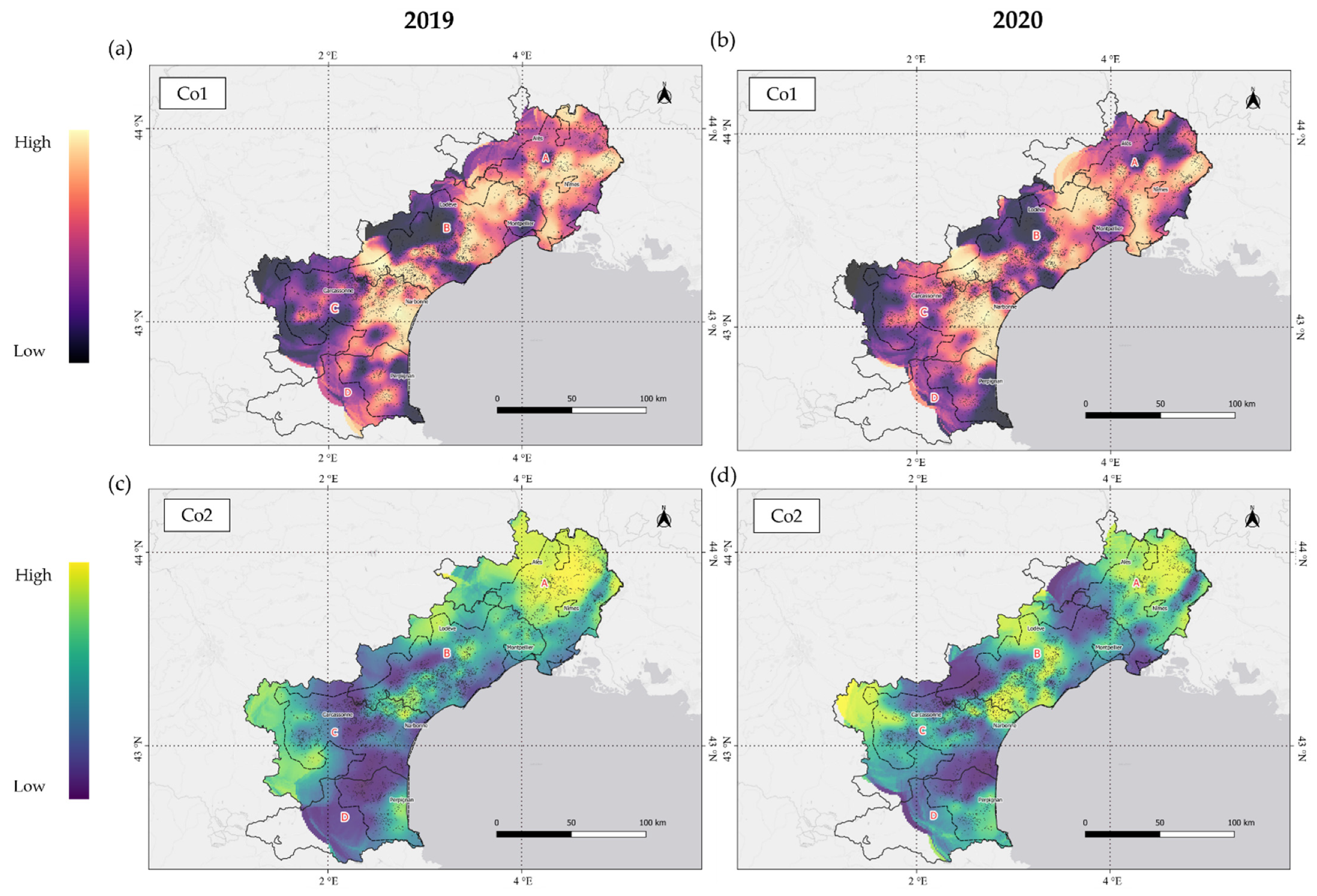
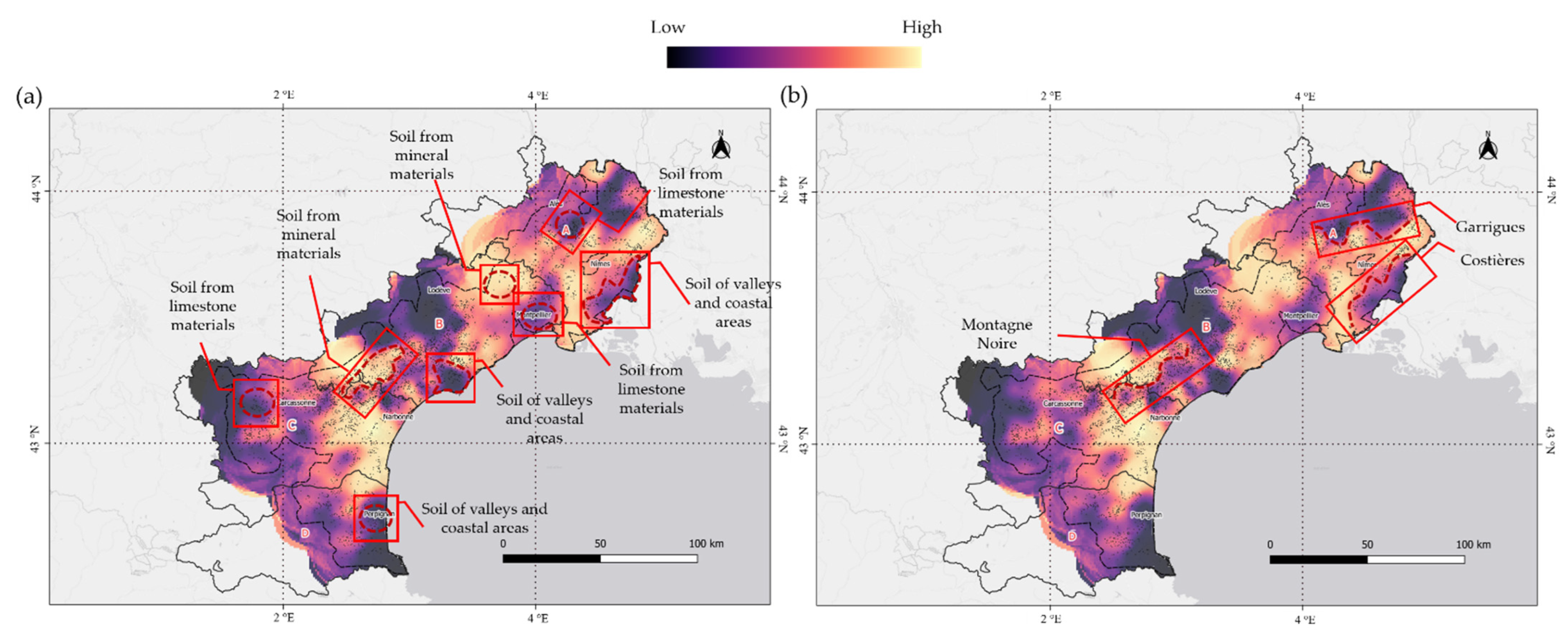
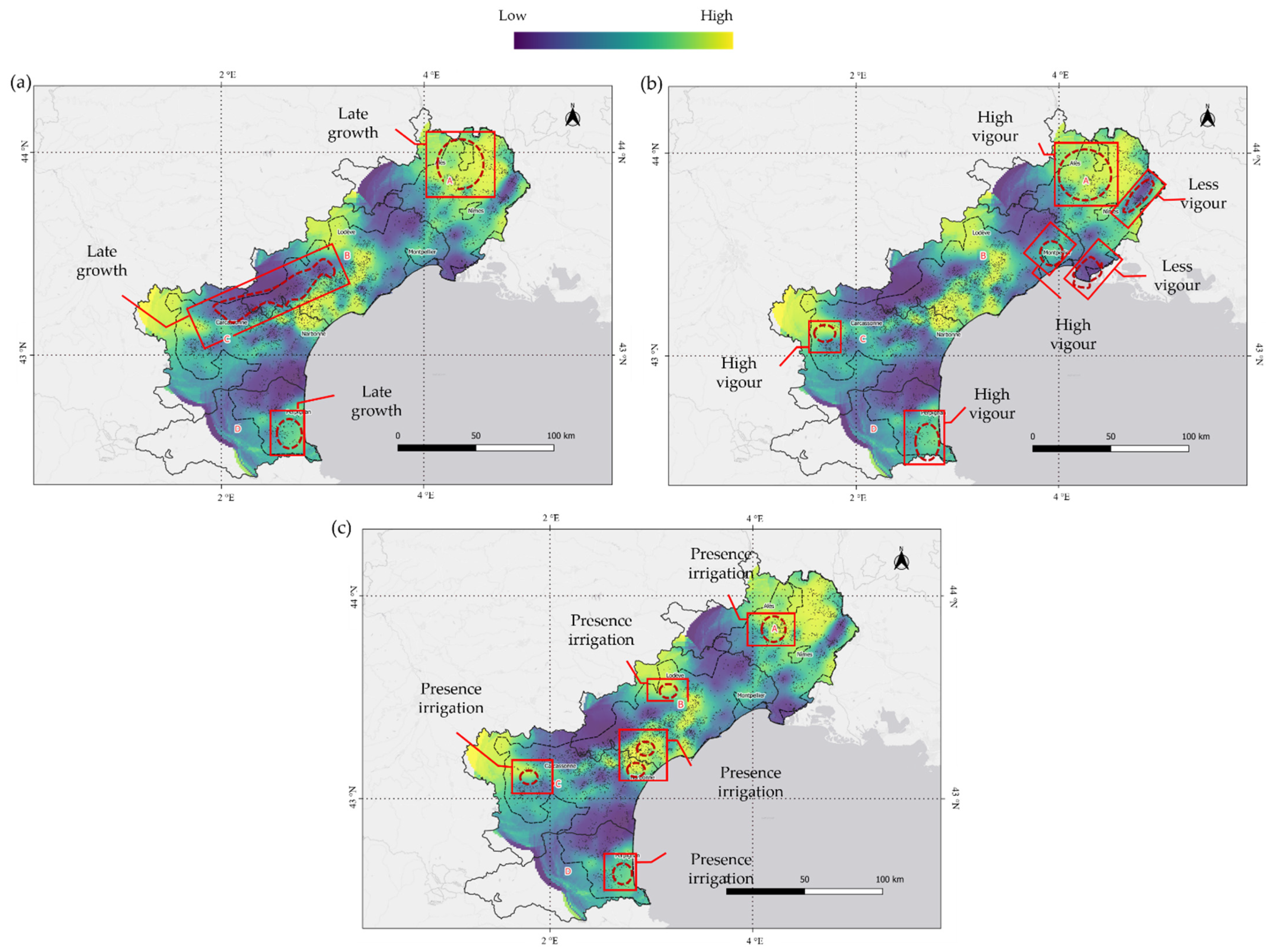
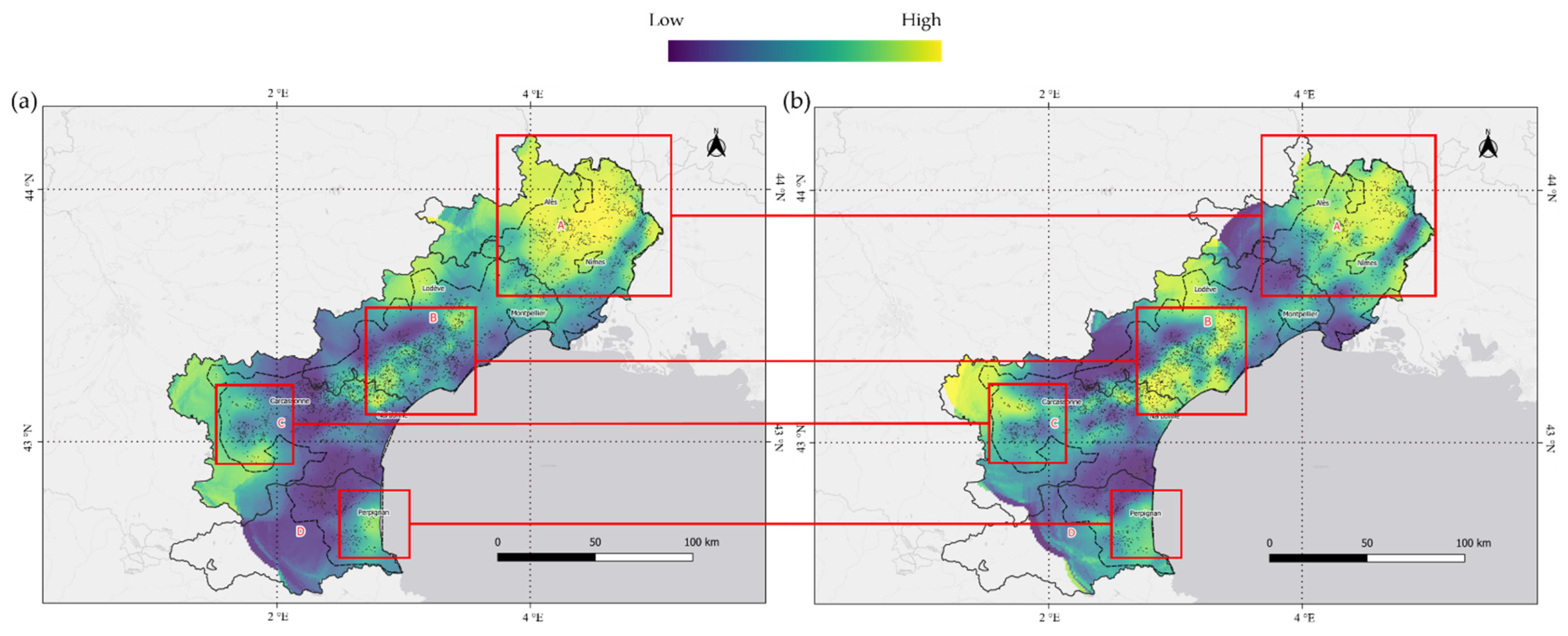
| Experience Grapevine Cultivation | Knowledge of Viticulture of the LR Region | Knowledge of Pedo-Climatic Characteristics of the LR Region | Expertise with Remote Sensing Images | ||||||||||
|---|---|---|---|---|---|---|---|---|---|---|---|---|---|
| Expert | Vine Physiology | Irrigation | Technical Itineraries | Climate Impact | Aude (A) | Gard (B) | Hérault (C) | Pyrénées-Orientales (D) | Soil Type | Micro-Climate | Data Processing | VIs | Resolution Scale |
| A1 | 5 | 5 | 4 | 4 | 4 | 2 | 4 | 3 | 2 | 2 | 3 | 4 | 3 |
| A2 | 4 | 3 | 3 | 3 | 3 | 3 | 4 | 4 | 3 | 3 | 4 | 4 | 4 |
| A3 | 4 | 4 | 4 | 4 | 1 | 3 | 2 | 1 | 3 | 3 | 1 | 2 | 1 |
| A4 | 4 | 5 | 4 | 4 | 4 | 4 | 4 | 4 | 4 | 4 | 4 | 4 | 1 |
| A5 | 2 | 1 | 3 | 2 | 3 | 1 | 5 | 1 | 5 | 5 | 1 | 1 | 3 |
| A6 | 4 | 5 | 5 | 4 | 4 | 4 | 4 | 3 | 4 | 3 | 3 | 5 | 4 |
| Step 1 | Step 2 | Step 3 | Step 4 | Step 5 | |
|---|---|---|---|---|---|
| Duration | 40 min | 20 min | 40 min | 20 min | 40 min |
| Type of session | Individual (written) | Individual (written) | Collective (oral) | Collective (oral) | Collective (oral) |
| Presentation of maps | Once at time for the year 2020 | All together for the 2020 year | Once at time for the year 2020 | All together for the 2020 year | All together for the years 2019 and 2020 |
| Year | Number of Components (F) | CORCONDIA (%) | Variance Explained (%) |
|---|---|---|---|
| 2019 | 1 | 100 | 99.25 |
| 2019 | 2 | 100 | 99.62 |
| 2019 | 3 | 15.65 | 99.74 |
| 2019 | 4 | −6.34 | 99.82 |
| 2029 | 5 | −0.72 | 99.88 |
| 2020 | 1 | 100 | 99.20 |
| 2020 | 2 | 100 | 99.57 |
| 2020 | 3 | 11.15 | 99.68 |
| 2020 | 4 | −0.23 | 99.79 |
| 2020 | 5 | −0.44 | 99.85 |
| Year | Components | Semivariogram Model | A1 (Km) | C0 | C1 | Ic (%) |
|---|---|---|---|---|---|---|
| 2019 | Co1 | Exponential | 6 | 0.067 | 0.079 | 45 |
| Co2 | Exponential | 6 | 0.026 | 0.022 | 53 | |
| 2020 | Co1 | Exponential | 5 | 0.205 | 0.113 | 64 |
| Co2 | Exponential | 5 | 0.145 | 0.086 | 62 |
| Component | Figure Number | Observations on | Sector A | Sector B | Sector C | Sector D |
|---|---|---|---|---|---|---|
| Co1 (Soil) | Figure 7a | Variation of pedological units | 5 | 5 | 2 | 1 |
| Figure 7b | Variation of geological units | 5 | 4 | 4 | 0 | |
| Co2 (Vegetation) | Figure 8a | Differences in grape varieties (phenology) | 4 | 2 | 3 | 1 |
| Figure 8b | Variation of vine vigour | 2 | 1 | 3 | 1 | |
| Figure 8c | Presence/absence of irrigation | 4 | 4 | 1 | 1 |
Publisher’s Note: MDPI stays neutral with regard to jurisdictional claims in published maps and institutional affiliations. |
© 2022 by the authors. Licensee MDPI, Basel, Switzerland. This article is an open access article distributed under the terms and conditions of the Creative Commons Attribution (CC BY) license (https://creativecommons.org/licenses/by/4.0/).
Share and Cite
Lopez-Fornieles, E.; Brunel, G.; Devaux, N.; Roger, J.-M.; Taylor, J.; Tisseyre, B. Application of Parallel Factor Analysis (PARAFAC) to the Regional Characterisation of Vineyard Blocks Using Remote Sensing Time Series. Agronomy 2022, 12, 2544. https://doi.org/10.3390/agronomy12102544
Lopez-Fornieles E, Brunel G, Devaux N, Roger J-M, Taylor J, Tisseyre B. Application of Parallel Factor Analysis (PARAFAC) to the Regional Characterisation of Vineyard Blocks Using Remote Sensing Time Series. Agronomy. 2022; 12(10):2544. https://doi.org/10.3390/agronomy12102544
Chicago/Turabian StyleLopez-Fornieles, Eva, Guilhem Brunel, Nicolas Devaux, Jean-Michel Roger, James Taylor, and Bruno Tisseyre. 2022. "Application of Parallel Factor Analysis (PARAFAC) to the Regional Characterisation of Vineyard Blocks Using Remote Sensing Time Series" Agronomy 12, no. 10: 2544. https://doi.org/10.3390/agronomy12102544
APA StyleLopez-Fornieles, E., Brunel, G., Devaux, N., Roger, J.-M., Taylor, J., & Tisseyre, B. (2022). Application of Parallel Factor Analysis (PARAFAC) to the Regional Characterisation of Vineyard Blocks Using Remote Sensing Time Series. Agronomy, 12(10), 2544. https://doi.org/10.3390/agronomy12102544









